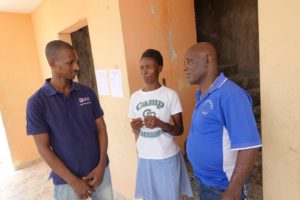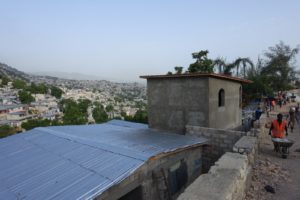This post was written by Michael de Vulpillieres, a member of the communications team at the American Red Cross Greater NY Region chapter. This past June, Michael traveled to Port-au-Prince to learn more about Red Cross programs in Haiti and to support the local Red Cross office. For more photos from Michael’s visit to Carrefour-Feuilles, click here.
Building supplies and construction equipment lined a newly-built road as I approached Campeche, one of the eight neighborhoods that comprises the community of Carrefour-Feuilles in western Port-au-Prince. It was about 7 a.m. and I was to spend the next few hours visiting one of the areas of the capital city most impacted by the 2010 earthquake.
My tour began in the narrow walkways of Campeche, accompanied my local colleagues proudly donning their Red Cross shirts. Area residents waved and smiled at us as my guides showed me around, pointing out countless projects along the way made possible by the American Red Cross and the partners we fund—retaining walls, latrines, repaired homes, foot paths, drainage systems, bridges, water points, schools and street lamps, just to name a few. Along with this work, my colleagues also indicated where new constriction financed by the American Red Cross—a health center, public squares, a soccer field, marketplaces and more water points—will soon break ground.
This infrastructure is critical in establishing a more functional and resilient community, in part because this poor area of Port-au-Prince was in desperate need of it even before the quake. Less than 40 years ago, this hill flanked by two steep ravines was sparsely populated. But the 1970s and 80s saw the population in Campeche and other parts of Carrefour-Feuilles skyrocket with a large influx of relatively poor residents moving here and building mostly makeshift homes. A fragile infrastructure barely followed suit and the zone quickly became one of the most densely populated and disaster-prone areas of Port-au-Prince.
So when the 7.0 magnitude earthquake struck on January 12, 2010, Campeche along with the rest of Carrefour-Feuilles was devastated. That’s why the American Red Cross and other groups designated this area as a priority zone for infrastructure and other community revitalization projects.
Today, local residents are leading the rebuilding effort here, with the help of organizations like the American Red Cross. The impact of such community improvement projects is obvious, but beneath the surface, beyond the bricks and mortar, Red Cross-funded youth, community preparedness, health and livelihoods programs are leaving their mark as well.
I spent the remainder of my morning with Achile, the manager of American Red Cross livelihoods programs in Carrefour-Feuilles. For two hours, he introduced me to half a dozen recipients of small business financing programs and village savings and loan associations (VSLA) made possible with American Red Cross support.
One of the individuals I met was Jeanneus Verdier, who joined a VSLA group in Campeche a year ago. As part of the group, neighbors pool their money over a nine month period and during this process provide loans to fellow members when needed for a small fee. Red Cross-funded partners empowered these groups with the training and other tools to make this lending possible. Verdier runs a local school and has used the money from two different loans to purchase cement for school repairs. He told me that without the loans, these improvements would not have been made. Verdier has since renewed his participation in the program.
My visit ended around noon, outside of Campeche in Post-au-Prince’s city center. Across a busy street from the national soccer stadium was the La Rencontre Restaurant, owned and operated for the last eight months by a young Campeche resident, Frantz Volma. After losing his job in 2013, Volma turned to an organization financed by the American Red Cross for a small-business loan to open his own restaurant. Today, the restaurant does brisk business; the best-selling item on the menu, “Poulet National,” the national chicken and rice dish of Haiti. As Vomar tells me with sense of relief on his face, “I don’t know where I would be without this loan.”
For more information about the American Red Cross’s ongoing work in Haiti, visit redcross.org/haiti.



